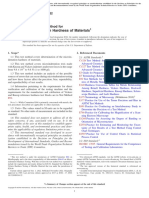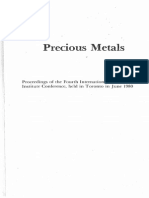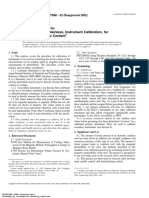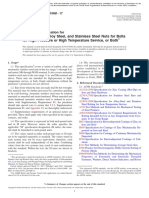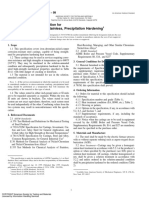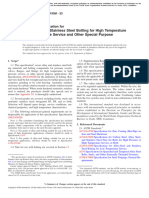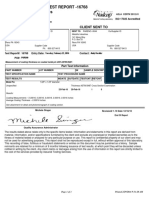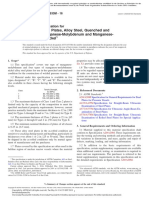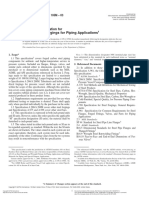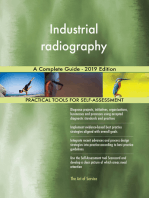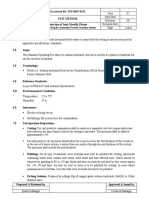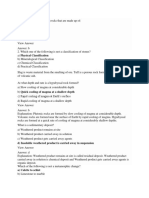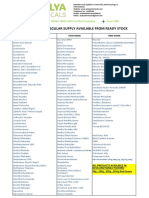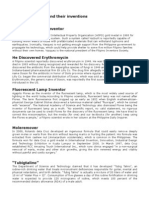STD-INSP-0123 IGC Practice - A - (ASTM G28)
STD-INSP-0123 IGC Practice - A - (ASTM G28)
Uploaded by
Akshay KalraCopyright:
Available Formats
STD-INSP-0123 IGC Practice - A - (ASTM G28)
STD-INSP-0123 IGC Practice - A - (ASTM G28)
Uploaded by
Akshay KalraOriginal Title
Copyright
Available Formats
Share this document
Did you find this document useful?
Is this content inappropriate?
Copyright:
Available Formats
STD-INSP-0123 IGC Practice - A - (ASTM G28)
STD-INSP-0123 IGC Practice - A - (ASTM G28)
Uploaded by
Akshay KalraCopyright:
Available Formats
Document No: STD-INSP-0123
Issue 02
Issue Date
TEST METHOD
Revision 00
Revision Date -
IGC Practice ‘A’ (ASTM G28)
Page 1 of 7
1.0 Purpose:
To establish and maintain the documented Procedure to ensure that the testing is carried out as per the
applicable specifications / standards.
2.0 Scope:
This test method describes the procedure for conducting the boiling ferric sulfate—50 %
sulfuric acid test which measures the susceptibility of certain nickel-rich, chromium-
bearing alloys to intergranular corrosion.
The uniform corrosion rate obtained by this test method, which is a function of minor
variations in alloy composition, may easily mask the intergranular corrosion components of
the overall corrosion rate on alloys N10276, N06022, N06059, and N06455.
3.0 Summary of Practice:
The purpose of this test method is to detect susceptibility to intergranular corrosion as influenced by
variations in processing or composition, or both. Materials shown to be susceptible may or may not
be intergranularly corroded in other environments.
A suitable sample of nickel-rich, chromium-bearing alloys, embedded in Ferric Sulphate –
Sulphuric acid for allocated boiling hours. After exposure in the boiling solution, the specimen is
measured by mass or calculated weight loss.
The presence of intergranular corrosion is usually determined by comparing the calculated corrosion
rate to that for properly annealed material.
4.0 Reference Standards :
As per ASTM G28 and customer Specification
5.0 Environmental Condition:
Temperature : 23 ± 5 ̊C
Humidity : N.A
6.0 Instrument :
A1-L glass Erlenmeyer flask with a ground 45/50 glass joint and four-bulb (minimum)
Allihn condenser with 45/50 ground glass joint are required and Hot Plate.
Prepared & Reviewed by Approved & Issued by
Quality Manager Technical Manager
Document No: STD-INSP-0123
Issue 02
Issue Date
TEST METHOD
Revision 00
Revision Date -
IGC Practice ‘A’ (ASTM G28)
Page 2 of 7
Specimen Supports—an open glass cradle capable of supporting the specimens with three –
four holes to increase circulation of the test solution around the specimen.
Boiling Chips for prevent bumping.
Prepared & Reviewed by Approved & Issued by
Quality Manager Technical Manager
Document No: STD-INSP-0123
Issue 02
Issue Date
TEST METHOD
Revision 00
Revision Date -
IGC Practice ‘A’ (ASTM G28)
Page 3 of 7
7.0 Test Specimen Preparation :
Size of specimen Requirement:
A specimen having a total surface area of 5 to 20 cm 2 is recommended.
The intent is to test a specimen representing as nearly as possible the material as used in service.
Sample with inclusion, porosity and slag is not allowed. Sample should be smooth machined,
cleaned and polished by 80, 120, 180 grit paper.
The size of the sample submitted for test and the area from which it is to be taken (end or middle of
coil, midway surface and center, and so forth) shall be specified by the customer. The testing
apparatus dictates the final size of the specimen. The size should be such that it should provide easy
entrance and removal from the neck of the container.
Specimens obtained by shearing should have the sheared edges machined or ground off prior to the
testing. Care should be taken while grinding to avoid overheating or burning.
Any scale on the surface should be removed mechanically unless specific surface finish is to be
evaluated. Chemical removal is allowed in this case. Mechanical removal should be done by 120
grit iron free aluminum oxide abrasive.
Each specimen sample should be de-greased using a cleansing solvent like acetone, ether prior to
testing.
7.1 Test Solution & Preparation :
Prepare 600ml. of 50 % (49.4 to 50.9 %) solution as follows :
First, measure 400ml. of Type IV reagent water in a 500ml. graduate and pour into the flask.
Then measure 236 ml. of reagent-grade sulfuric acid (H2SO4) of a concentration which must be in
the range from 95.0 to 98.0 weight percent in a 250ml. graduate. Add the acid slowly to the water in
the flask to avoid boiling by the heat evolved. Externally cooling the flask with water during the
mixing will also reduce overheating.
Prepared & Reviewed by Approved & Issued by
Quality Manager Technical Manager
Document No: STD-INSP-0123
Issue 02
Issue Date
TEST METHOD
Revision 00
Revision Date -
IGC Practice ‘A’ (ASTM G28)
Page 4 of 7
Weigh 25 g of reagent grade ferric sulfate (contains about 75 % Fe2 (SO4)3) and add to the H2SO4
solution.
Add boiling chips & Lubricate the ground glass of the condenser joint with silicone grease.
Cover the flask with the condenser and circulate cooling water & Boil the solution until all ferric
sulfate is dissolved.
7.3 Testing boiling cycle :
The boiling ferric sulfate-sulfuric acid test may be applied to the following alloys in the wrought
condition:
Sl No. Alloy Testing time, h
1 N06007 120
2 N06022 24
3 N06030 120
4 N06059 24
5 N06200 24
6 N06455 24
7 N06600 24
8 N06625 120
9 N06686 24
10 N06985 120
11 N08020 120
12 N08367 24
13 N08800 120
14 N08825 120
15 N10276 24
8.0 Test Method / procedure :
Place the specimen in the glass cradle, remove the condenser, immerse the cradle by means of a
hook in the actively boiling solution and immediately replace the condenser. A fresh solution should
be used for each test.
Mark the liquid level on the flask with wax crayon to provide a check on vapor loss which would
result in concentration of the acid. If there is an appreciable change in the level (a 0.5-cm or more
drop), repeat the test with fresh solution and with a fresh specimen or a reground specimen.
Prepared & Reviewed by Approved & Issued by
Quality Manager Technical Manager
Document No: STD-INSP-0123
Issue 02
Issue Date
TEST METHOD
Revision 00
Revision Date -
IGC Practice ‘A’ (ASTM G28)
Page 5 of 7
Continue immersion of the specimen for the length of time specified in above table (Section 7.3),
then remove the specimen, rinse in water and acetone, and dry.
Weigh the specimen and subtract this mass from the original mass.
If the corrosion rate is extraordinarily high in Method A, as evidenced by a change in color (green)
of the solution, additional ferric sulfate must be added during the test. The amount of ferric sulfate
that must be added, if the total mass loss of all specimens exceeds 2 g as indicated by an
intermediate weight, is 10 g for each 1 g of dissolved alloy. This does not apply to Method B.
In this method, several specimens of the same alloy may be tested simultaneously. The number (3 or
4) is limited only by the number of glass cradles that can be fitted into the flask and the
consumption of ferric sulfate. Only one sample should be tested in a flask for Method B.
9.0 Calculation & Interpretation of results :
9.1 Calculation:
Measure the effect of the acid solution on the material.
Corrosion rate = (K x W) / (A x T x D)
Where:
K = a constant (see below table),
T = time of exposure, h, to the nearest 0.01 h,
A = area, cm2, to the nearest 0.01 cm2,
W = mass loss, g, to the nearest 0.001 g, and
D = density, g/cm3 (see below table).
Corrosion rate Density
Constant K in
Corrosion Rate Units
corrosion rate UNS Designation Density, g/cm3
Desired
equation
mils per year (mpy) 3.45 × 106 N06007 8.31
inches per year (ipy) 3.45 × 103 N06022 8.69
inches per month (ipm) 2.87 × 102 N06030 8.22
millimeters per year (mm/Y) 8.76 × 104 N06059 8.80
micrometers per year (μm/y) 8.76 × 107 N06200 8.50
pedometers per second (pm/s) 2.78 × 106 N06455 8.64
grams per square meter-hour
1.00 x 104 x DB N06600 8.41
(g/m2-h)
milligrams per square
2.40 x 106 x DB N06625 8.44
decimeter-day (mdd)
micrograms per square meter-
2.78 x 106 x DB N06686 8.73
second (μg/m 2-s)
Prepared & Reviewed by Approved & Issued by
Quality Manager Technical Manager
Document No: STD-INSP-0123
Issue 02
Issue Date
TEST METHOD
Revision 00
Revision Date -
IGC Practice ‘A’ (ASTM G28)
Page 6 of 7
-- -- N06985 8.31
-- -- N08020 8.05
-- -- N08367 8.06
-- -- N08800 8.03
-- -- N08825 8.14
-- -- N10276 8.87
Prepared & Reviewed by Approved & Issued by
Quality Manager Technical Manager
Document No: STD-INSP-0123
Issue 02
Issue Date
TEST METHOD
Revision 00
Revision Date -
IGC Practice ‘A’ (ASTM G28)
Page 7 of 7
9.2 Interpretation of results:
The presence of intergranular corrosion is usually determined by comparing the calculated corrosion
rate to that for properly annealed material.
As an alternative or in addition to calculating a corrosion rate from mass loss data, metallographic
examination may be used to evaluate the degree of intergranular corrosion. The depth of attack
considered acceptable shall be determined between buyer and seller.
10.0 Recording of observations:
Record all the data in Form No.
11.0 Estimation of uncertainly:
Reported Uncertainty of calibration certificate of weighing scale (Normal Distribution)
Reported Uncertainty of calibration certificate of measuring scale (i.e. vernier caliper or
micrometer) (Normal Distribution)
Prepared & Reviewed by Approved & Issued by
Quality Manager Technical Manager
You might also like
- Detecting Detrimental Intermetallic Phase in Duplex Austenitic/Ferritic Stainless SteelsDocument10 pagesDetecting Detrimental Intermetallic Phase in Duplex Austenitic/Ferritic Stainless SteelsBaskar VNo ratings yet
- Astm A262-21Document20 pagesAstm A262-21Chetan D100% (2)
- 652-100-FINAL (ITP) Rev1Document4 pages652-100-FINAL (ITP) Rev1Anonymous AdofXEYAgENo ratings yet
- Astm E384-22Document40 pagesAstm E384-22v santosh kumarNo ratings yet
- Astm E415 - 21Document12 pagesAstm E415 - 21Daniel CadorchaNo ratings yet
- ASTM E2660 RadiographyDocument5 pagesASTM E2660 RadiographyalirezaattariNo ratings yet
- Astm E1245-2003-R-2008Document8 pagesAstm E1245-2003-R-2008Pedro Tavares Murakame100% (1)
- Measuring Flatness Characteristics of Steel Sheet Products: Standard Practice ForDocument9 pagesMeasuring Flatness Characteristics of Steel Sheet Products: Standard Practice Forguillermo aponte100% (1)
- General Requirements For Flat-Rolled Nickel and Nickel Alloys Plate, Sheet, and StripDocument16 pagesGeneral Requirements For Flat-Rolled Nickel and Nickel Alloys Plate, Sheet, and StripIvan Alexandre Lopes100% (1)
- Precious Metals-R.O. McGachie and A.G. BradleyDocument327 pagesPrecious Metals-R.O. McGachie and A.G. BradleyirvingdirzoNo ratings yet
- Astm A1016 - A1016m - 13Document11 pagesAstm A1016 - A1016m - 13Ali KatamipourNo ratings yet
- Astm G39-99-2021Document8 pagesAstm G39-99-2021hashem Al-NasserNo ratings yet
- E384 31110Document40 pagesE384 31110GonzaloNo ratings yet
- ASTM A604A604M 07 (Reapproved 2022) Macroetch - Testing - of - Consumable - ElectrodeDocument14 pagesASTM A604A604M 07 (Reapproved 2022) Macroetch - Testing - of - Consumable - ElectrodeVijay KumarNo ratings yet
- AMS2175ADocument20 pagesAMS2175AKanikannan SamyduraiNo ratings yet
- Astm A789Document6 pagesAstm A789shahid khan100% (1)
- Macroetch Testing of Tool Steel Bars: Standard Practice ForDocument2 pagesMacroetch Testing of Tool Steel Bars: Standard Practice ForMax100% (1)
- Astm A 799 PDFDocument4 pagesAstm A 799 PDFOkinawa TeakNo ratings yet
- ASTM-B487-20 RedlineDocument4 pagesASTM-B487-20 Redlinemarcio de rossi100% (1)
- A194a194m 17Document13 pagesA194a194m 17jcarlos7411No ratings yet
- Iso 945-1-2019Document43 pagesIso 945-1-2019sharma.sumeet2290No ratings yet
- Mechanical Testing of Steel Products-Metric: Standard Test Methods ForDocument11 pagesMechanical Testing of Steel Products-Metric: Standard Test Methods ForCJPATAGANNo ratings yet
- SB 637 (Asme)Document8 pagesSB 637 (Asme)Cristiane KassaNo ratings yet
- CA6NMDocument2 pagesCA6NMjoene3No ratings yet
- Astm B166 2019Document9 pagesAstm B166 2019reza acbariNo ratings yet
- ASTM A747-Standard-Specification-For-Steel-Castings-Stainless-Precipitation-Hardening PDFDocument4 pagesASTM A747-Standard-Specification-For-Steel-Castings-Stainless-Precipitation-Hardening PDFRaul Dela Rosa Malanog100% (1)
- Copper and Copper Alloy Forging Rod, Bar, and Shapes: Standard Specification ForDocument8 pagesCopper and Copper Alloy Forging Rod, Bar, and Shapes: Standard Specification Foralucard375No ratings yet
- Astm A194-22Document12 pagesAstm A194-22Gary CabelloNo ratings yet
- Astm A487 - 2021Document7 pagesAstm A487 - 2021juanvrcicNo ratings yet
- Astm A193 - A193m-23Document14 pagesAstm A193 - A193m-23ashrafNo ratings yet
- Astm A182 A182m 22Document7 pagesAstm A182 A182m 22Adco forge & fittings pvt ltdNo ratings yet
- ASTM E 1245 - 03 (Reapproved 2008)Document8 pagesASTM E 1245 - 03 (Reapproved 2008)Ali Saleh Saad AL-isawiNo ratings yet
- STD-INSP-0124 IGC Practice - B - (ASTM G28)Document4 pagesSTD-INSP-0124 IGC Practice - B - (ASTM G28)Akshay KalraNo ratings yet
- Astm B571-97 PDFDocument3 pagesAstm B571-97 PDFDillonNo ratings yet
- As 2205.7.1-2003 Methods For Destructive Testing of Welds in Metal - Charpy V-Notch Impact Fracture ToughnessDocument2 pagesAs 2205.7.1-2003 Methods For Destructive Testing of Welds in Metal - Charpy V-Notch Impact Fracture ToughnessSAI Global - APAC0% (1)
- ASTM A194 A194M 2022 InglesDocument3 pagesASTM A194 A194M 2022 InglesErickNo ratings yet
- Astm E340-2023Document11 pagesAstm E340-2023Saravana VelNo ratings yet
- ASTM A781A781M Standard Specification For Castings, Steel and Alloy, Common Requirements, For General Industrial UseDocument12 pagesASTM A781A781M Standard Specification For Castings, Steel and Alloy, Common Requirements, For General Industrial Usealucard375No ratings yet
- Astm A995 A995m 13 2013 PDFDocument4 pagesAstm A995 A995m 13 2013 PDFdelta lab sangli0% (1)
- ASTM A928, 2014 Standard Specification For Ferritic-Austenitic (Duplex) Stainless Steel Pipe Electric Fusion Welded With Addition of Filler MetalDocument7 pagesASTM A928, 2014 Standard Specification For Ferritic-Austenitic (Duplex) Stainless Steel Pipe Electric Fusion Welded With Addition of Filler MetalArcadio DuranNo ratings yet
- General Requirements For Alloy and Stainless Steel PipeDocument12 pagesGeneral Requirements For Alloy and Stainless Steel Pipebehzad mohammadiNo ratings yet
- Astm e 930 1999 (R 2015)Document6 pagesAstm e 930 1999 (R 2015)Salvatore Manni OcchinoNo ratings yet
- Astm B487Document2 pagesAstm B487Srinivasa RaghavanNo ratings yet
- A 247 - 17 PDFDocument13 pagesA 247 - 17 PDFأسامة وحيد الدين رمضان100% (1)
- Astm E407Document21 pagesAstm E407Chan UeiNianNo ratings yet
- Pressure Vessel Plates, Alloy Steel, Quenched and Tempered, Manganese-Molybdenum and Manganese-Molybdenum-NickelDocument3 pagesPressure Vessel Plates, Alloy Steel, Quenched and Tempered, Manganese-Molybdenum and Manganese-Molybdenum-Nickelalucard375No ratings yet
- Pitting and Crevice Corrosion Resistance of Stainless Steels and Related Alloys by Use of Ferric Chloride SolutionDocument11 pagesPitting and Crevice Corrosion Resistance of Stainless Steels and Related Alloys by Use of Ferric Chloride SolutionName100% (2)
- Astm A105Document5 pagesAstm A105mahamad AziNo ratings yet
- General Requirements For Flat-Rolled Stainless and Heat-Resisting Steel Plate, Sheet, and StripDocument26 pagesGeneral Requirements For Flat-Rolled Stainless and Heat-Resisting Steel Plate, Sheet, and StripSajal DeyNo ratings yet
- Astm A800Document6 pagesAstm A800utreshwarmiskinNo ratings yet
- Chemical Analysis of Steel Products: Standard Test Methods, Practices, and Terminology ForDocument6 pagesChemical Analysis of Steel Products: Standard Test Methods, Practices, and Terminology ForoslatNo ratings yet
- Analysis of Cast Iron by Spark Atomic Emission Spectrometry: Standard Test Method ForDocument7 pagesAnalysis of Cast Iron by Spark Atomic Emission Spectrometry: Standard Test Method ForTuan Anh100% (1)
- Astm E92 PDFDocument9 pagesAstm E92 PDFoscar_sm77No ratings yet
- Bolted Flanged Joint: Flanges, Studs & Gaskets. Recommended Practices for the Assembly of a Bolted Flange Joint.From EverandBolted Flanged Joint: Flanges, Studs & Gaskets. Recommended Practices for the Assembly of a Bolted Flange Joint.No ratings yet
- STD-INSP-0125 IGC Phases Practice - A - (ASTM A923) DUPLEXDocument2 pagesSTD-INSP-0125 IGC Phases Practice - A - (ASTM A923) DUPLEXAkshay KalraNo ratings yet
- QC - 08 PTCDocument5 pagesQC - 08 PTCmahendra100% (1)
- QC - 16 Guided Bend Test.Document3 pagesQC - 16 Guided Bend Test.mahendra100% (1)
- 3dd028-N12-Api 6fa Fire Safe Test Procedure For High and Low Pressure Ball ValvesDocument7 pages3dd028-N12-Api 6fa Fire Safe Test Procedure For High and Low Pressure Ball ValvesPrathik Yeresh ReddyNo ratings yet
- Astm D127 19Document6 pagesAstm D127 19caxoro1799No ratings yet
- Daftar Dosis Dan Sediaan Obat AnakDocument5 pagesDaftar Dosis Dan Sediaan Obat AnakDaman Gregorius ManikNo ratings yet
- Tankguard ARDocument4 pagesTankguard ARSherif Abdelhameed100% (1)
- 186 Soldering Flux Data SheetDocument2 pages186 Soldering Flux Data SheetBéla BődiNo ratings yet
- Study ThisDocument83 pagesStudy Thispavithiran subramaniNo ratings yet
- Formulations HaircareDocument1 pageFormulations Haircarezaryab khanNo ratings yet
- B-1050 EL Resilient 2012-08Document24 pagesB-1050 EL Resilient 2012-08Karthick VenkateshNo ratings yet
- Emulsion Dynamic Viscosity StandardDocument12 pagesEmulsion Dynamic Viscosity StandardSathish Kumar SubramaniNo ratings yet
- Lecture 18Document4 pagesLecture 18lldgee33No ratings yet
- ASME PD-442 Brochure November - 2015Document5 pagesASME PD-442 Brochure November - 2015AehteshamShaikhNo ratings yet
- Abdolmohsen Shabib-Asl, 2014 Referensi PPMDocument8 pagesAbdolmohsen Shabib-Asl, 2014 Referensi PPMAdzan Topaz AdityaNo ratings yet
- Future Nano DevelopmentDocument13 pagesFuture Nano DevelopmentSylvanus JenkinsNo ratings yet
- Ciba Irgamet 42: Water Soluble Metal DeactivatorDocument8 pagesCiba Irgamet 42: Water Soluble Metal DeactivatorRodrigoNo ratings yet
- Juice Wine Cider Making Pricing 2016Document55 pagesJuice Wine Cider Making Pricing 2016Andrei GavrilaNo ratings yet
- Sku Descripcion Fabricante Stoc KDocument35 pagesSku Descripcion Fabricante Stoc Kleidy andrea serrano caceresNo ratings yet
- Hanshin Hs 1606vdDocument2 pagesHanshin Hs 1606vdnotaden1849100% (2)
- 3 TekniFloor LDPDocument2 pages3 TekniFloor LDPAndy100% (1)
- Katalis 6%Document16 pagesKatalis 6%Ainan AziziNo ratings yet
- Elkem InoculacaoDocument26 pagesElkem Inoculacaoeduardolavrati100% (1)
- T441Document5 pagesT441Pratik PrajapatiNo ratings yet
- G9 ChemistryDocument1 pageG9 ChemistryjanithaNo ratings yet
- Mcqs For Basics Civil EngineeringDocument44 pagesMcqs For Basics Civil EngineeringWasim KhanNo ratings yet
- Dod-Std-1866 Notice 1 1988Document33 pagesDod-Std-1866 Notice 1 1988liuyx866No ratings yet
- Images of Distillation ColumnsDocument6 pagesImages of Distillation ColumnsFarrukh IqbalNo ratings yet
- Product List 2019-2020 (Solvent)Document1 pageProduct List 2019-2020 (Solvent)Sazeed Sha52hNo ratings yet
- C1161 - 08 Flexural CeramicDocument16 pagesC1161 - 08 Flexural CeramicRedV1rusNo ratings yet
- Omi Baro 1097Document11 pagesOmi Baro 1097Nick Smith100% (1)
- Faculty Selection Test Chemistry: Pre-Foundation Sample PaperDocument7 pagesFaculty Selection Test Chemistry: Pre-Foundation Sample PaperRam Ji PandeyNo ratings yet
- Research Note On Aluminium Alloy Property PDFDocument80 pagesResearch Note On Aluminium Alloy Property PDFpenghzNo ratings yet
- Untitled 1Document1 pageUntitled 1Daphne VillaromanNo ratings yet



